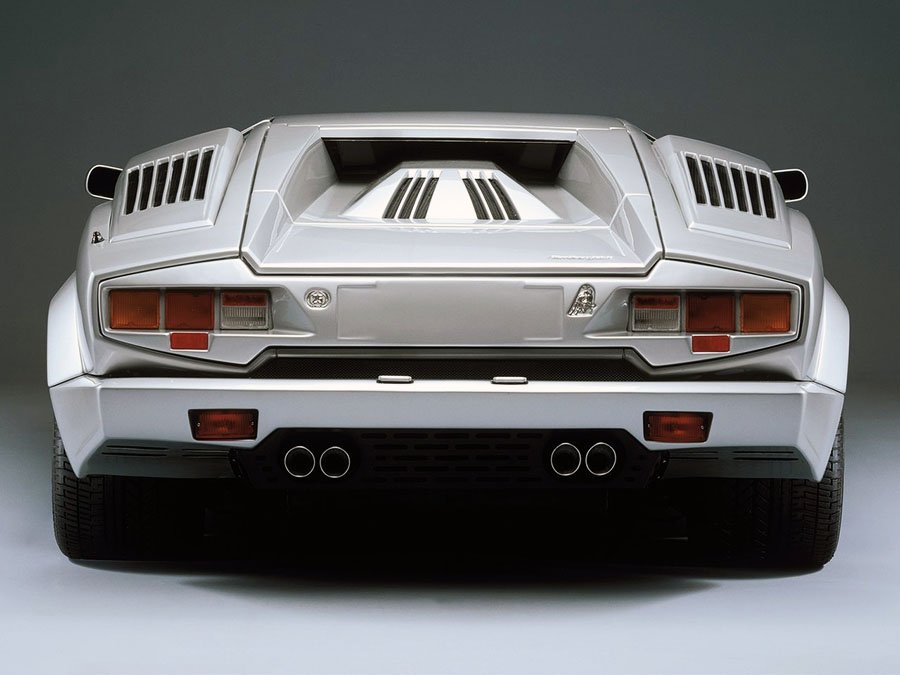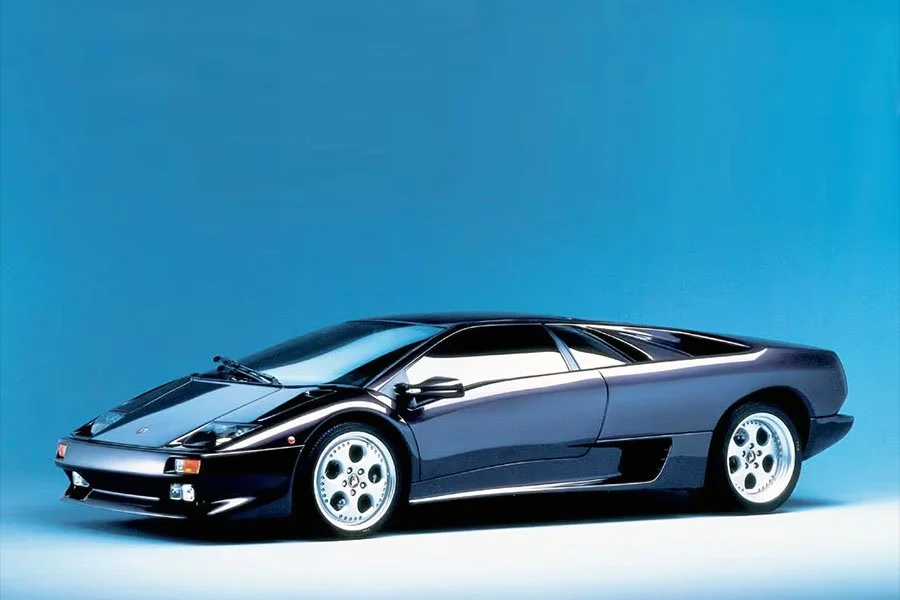Guide: Face-Lifted Finale - a Historical & Technical Appraisal of the Lamborghini Countach 25th Anniversary
/BACKGROUND
When Chrysler took control of Automobili Lamborghini in April 1987, the Italian firm’s replacement for the legendary Countach was already at an advanced stage of development with production slated to begin in late 1988.
The new car, dubbed P132, was to receive an enlarged 5.7-litre iteration of the fabled dual overhead cam V12 with electronic engine management and fuel-injection now standard across all markets. A more spacious cockpit with properly opening windows had also been created along with a softened exterior profile in line with modern trends.
Although Chrysler management found itself satisfied with the technical side of the P132, the same could not be said of the new car’s Marcello Gandini-designed bodywork. Accordingly, during the final stages of development it was decided to go for a complete cosmetic redesign of the highly anticipated machine which would subsequently become the Diablo.
With a circa 18-month delay on the cards until the Diablo was ready, Chrysler decided to create a face-lifted last-of-the-line Countach.
The resultant Quattrovalvole-based Countach 25th Anniversary would be the third production re-styling of the Countach after the original LP400 of 1973 and subsequent wide-bodied Countach S of 1978 (both of which Marcello Gandini had produced while serving as head stylist at Bertone, a position he left in 1980).
The finished Countach Anniversary was produced in double quick time and unveiled at the Sant’Agata factory in September 1988. As the name suggested, it celebrated a quarter of a century since Lamborghini’s first model, the 350 GTV, had been unveiled back in 1963.
Meanwhile, on behalf of the fledgling Cizeta motor company, Gandini made a couple of revisions to the P132 design that Chrysler had rejected and this went on to become the fabled Cizeta V16T.
BODYWORK
The task of re-styling the existing Countach Quattrovalvole was given to Lamborghini’s composites expert, Horacio Pagani. Around a year earlier, Pagani had been the architect behind the legendary Countach Evoluzione which served as a mobile test bed for evaluating the advanced composite technology that had long since been a fixture in Formula 1 and was now beginning to find its way into high end road cars.
For the Countach Anniversary, Pagani devised a US-style front bumper assembly, under which was a deep apron that housed the fog lights and brake cooling intakes along with a pair of straked ducts down each flank. Further up, frosted instead of clear covers were fitted over the sidelight / indicator panels.
The Anniversary also adopted the same style of straked side skirts from the 1988 spec. Quattrovalvole albeit now more neatly integrated with the rear wheelarch extension and with re-shaped, deeper bottom sections.
All four wheelarch extensions were subtly modified to blend more cohesively into the bodywork.
At the back, a proper rear bumper was fitted to all cars regardless of which market they were destine for and the exhaust was encased within a vented satin black shroud. Lamborghini also fitted a new tail panel that spanned the entire rear fascia and obscured the original trademark light clusters in a fashion typical of previous US market cars. Between the light clusters were Lamborghini and 25th Anniversary emblems. A Lamborghini script was added to the trunk lid
Elsewhere, the boxy sail panel mounted intake scoops behind each rear quarter window and the satin black vent panel further back were dropped in favour of a more aerodynamic single piece housing. The engine cover with its distinctive power bulge was also completely redesigned.
Body coloured wing mirror casings were fitted too
Many of the new body parts were manufactured from composite materials. Meanwhile, Bertone continued to manufacture the original steel panels at their Turin facility and for this reason the coachbuilder’s badges were affixed to each rear fender.
INTERIOR
Thanks to new pleated seats with matching door panels and a new three-spoke steering wheel, the Anniversary’s cockpit looked quite different to any prior iteration of the Countach.
Instead of fixed-back units, the seats were now two-piece items with adjustable backs and headrests. Seat adjustment was fully electric for the first time.
Also switched to electric operation were the windows, the switches for which were mounted behind the ashtray on the transmission tunnel.
Elsewhere on the transmission tunnel were updated digital ventilation controls for the much-improved ventilation system and a re-shaped gear knob.
In addition to the redesigned seats and door panels, the sills were re-shaped and now incorporated a covered storage bin.
The Anniversary’s dash assembly was imported from the 1988 Quattrovalvole which meant the instrumentation layout remained as before. Housed directly behind the three-spoke leather-rimmed steering wheel in a rectangular binnacle was a large speedometer and rev counter with a smaller oil pressure gauge in between. Off to the left were more small gauges for oil temperature and battery amps. To the right were read outs for water temperature and fuel.
CHASSIS
In order to accommodate even wider forged split rim OZ wheels, the Anniversary’s suspension geometry was reconfigured which led to improved handling and stability.
The wheels themselves retained a 15-inch diameter, but were now 8.5-inches wide at the front (up from 7.5) and 12-inches wide at the back (up from 9.5). They were also shod with the latest Pirelli P Zero tyres (225/50 VR15 and 345/35 VR15 respectively).
As before, the Anniversary was based around a round tubed spaceframe chassis. The floorpan was a mixture of fibreglass composite and steel. Fuel tanks with a combined capacity of 120-litres were housed in each sill.
Suspension was independent all round. It comprised double wishbones at the front with upper lateral links, reversed lower wishbones and upper and lower trailing arms at the back. Coil springs and telescopic Koni dampers were installed at each corner (two per side at the rear). Anti-roll bars were fitted at either end.
The brake discs had a 300mm diameter at the front and 284mm diameter at the rear. Four-piston calipers were installed all round.
ENGINE / TRANSMISSION
In the Anniversary’s engine bay was an identical Tipo LP112 D version of the all-alloy DOHC V12 that had been used in the Quattrovalvole.
In addition to its new four valve cylinder heads with pentagonal combustion chambers, the QV motor had been enlarged by 413cc over the outgoing 5000 S motor by virtue of its 6mm longer stroke. Overall displacement was 5167cc thanks to bore and stroke dimensions of 85.5mm and 75mm respectively.
The big valve QV engine also ran a higher compression ratio than its predecessor (9.5:1 as opposed to 9.2:1) along with six downdraught Weber 44 DCNF carburettors instead of the sidedraught 45 DCOEs used previously.
Peak output was 455bhp at 7000rpm and 369lb-ft at 5200rpm.
In addition to this ‘Rest of World’ engine, Lamborghini also offered a fuel-injected version for markets like North America where tighter emissions regulations were in play.
Bosch KE Jetronic fuel-injection replaced the Weber carburettors and enabled installation of a re-profiled engine cover with raised side sections and three banks of cooling vents that meant rear vision was much-improved.
Peak output of the fuel-injected motor was 420bhp at 7000rpm with an unchanged torque rating.
Transmission was via Lamborghini’s five-speed manual gearbox, a single-plate clutch and limited-slip differential.
OPTIONS
Instead of the standard electric items, customers could order their Countach Anniversary with the rarely seen Sport seat option. These gave a little more headroom and came with fixed backs and manual adjustment.
Other new options were contrast seat piping (only available with the standard electric seats) and a mono or bi-colour steering wheel.
As before, an Alpine audio system, rear spoiler and sports exhaust were also available along with out-of-range paint and interior shades.
WEIGHT / PERFORMANCE
Despite its myriad composite body panels, the Anniversary weighed in 100kg heavier than the outgoing Quattrovalvole (1590kg as opposed to 1490kg).
Nevertheless, thanks to its improved aerodynamics, top speed was now 2mph higher (190mph instead of 188mph).
The 0-62mph time was officially unchanged at 4.8 seconds.
END OF PRODUCTION
The last Anniversary was manufactured in July 1990 and brought Countach production to a close after 17 years.
Thanks to a booming collector car market, 657 examples of the Anniversary were completed which made it the best selling Countach of all. 205 were fuel-injected North American spec. variants and 67 were right-hand drive.
Text copyright: Supercar Nostalgia
Photo copyright: Lamborghini - https://www.lamborghini.com





































